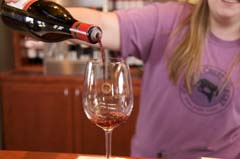Tasting Rooms: Trends and Areas Needing Improvement
By John ~ August 29th, 2008.
 On February 8th, I did a post on Tips for visiting wine country which included advice on being friendly and polite and respecting the time of the people working in a tasting room. Since then, we have visited over 100 winery tasting rooms in 15 different states. Based on those visits, I’d like to share a couple trends I’ve observed as well as suggest some areas where tasting rooms could improve the experience for their visitors.
On February 8th, I did a post on Tips for visiting wine country which included advice on being friendly and polite and respecting the time of the people working in a tasting room. Since then, we have visited over 100 winery tasting rooms in 15 different states. Based on those visits, I’d like to share a couple trends I’ve observed as well as suggest some areas where tasting rooms could improve the experience for their visitors.
First, the trends:
- More and more winery tasting rooms charge tasting fees. While I would prefer no tasting fees, I understand the problems wineries face with busloads just out for a free party or locals using the tasting room as a free bar. Therefore, I can live with a tasting fee for groups of eight or more or a tasting fee that is refundable with the purchase of wine. However, I try to avoid tasting rooms with a totally non-refundable tasting fee. There are too many other good wineries out there that have customer-friendly policies.
- More and more winery tasting rooms are pouring wines not available elsewhere. For me, this trend is worse than a tasting fee. I visit winery tasting rooms primarily to find good new wines to taste that I will be able to buy when I get back home if I like them. If the wines they pour are not available outside of the tasting room, I lose interest quickly. While I realize that the winery can possibly make more sales in the tasting room today with the “pitch†that it’s not available elsewhere, I really do not believe it helps them in the long run.
Now, the areas needing improvement. In addition to the comments I made above, here are some suggestions that I have for tasting rooms:
- Make sure that you are open during the hours that you have advertised or posted that you are open. As our regular readers know, nothing ticks us off more than a tasting room not open as advertised. I doubt that we are alone on this one. You usually don’t get a second chance to make a first impression, so be sure to change your hours on your website and all other places you advertise before you just decide to close today because it hasn’t been very busy recently on this day of the week. If I have driven five hours to visit you, I will not be a happy camper. And the “I†I’m referring to might not be me but could be the biggest potential customer or promoter of your wines that you’ll ever have.
 Make sure that you clearly explain your tasting fee policy, if any, up front. Better yet, have it posted clearly and explain it. I’ve seen it get very awkward when it was not explained up front and a visitor has already finished tasting when the tasting fee is brought to their attention. That situation can poison the atmosphere for everyone else in the tasting room, too.
Make sure that you clearly explain your tasting fee policy, if any, up front. Better yet, have it posted clearly and explain it. I’ve seen it get very awkward when it was not explained up front and a visitor has already finished tasting when the tasting fee is brought to their attention. That situation can poison the atmosphere for everyone else in the tasting room, too.- Have a handout with tasting notes and a price list. Too often, tasting notes and a price list are nonexistent or either they are in a laminated copy on the counter but not on a sheet on which a visitor can make notes and take with them.
- Have spit cups and dump buckets available. I have been amazed at how many tasting rooms do not even have dump buckets, much less provide at least a styrofoam spit cup (or the “green†equivalent). If you are serious about promoting responsible wine drinking, then you should encourage your visitors to spit rather than swallow, especially since many will be driving and visiting other wineries as well.
- Give your tasting room personnel some flexibility in wines to pour. Again, when I drive five hours to visit your tasting room that is 30 miles from anyone else just to taste a Cab you are noted for, pay a tasting fee, and then your tasting room person tells me you’re not pouring the Cab today, I get more than a little upset. My suggestion is that you give your tasting room personnel the flexibility to open that Cab if they can see that the visitor is a serious wine enthusiast and not just a freeloader.
- Cool your uppity attitude. Obviously, this suggestion does not apply to all tasting rooms as we have had many wonderful experiences and met some very friendly people on our winery visits. In fact, when we have been served by the owners and/or winemakers in a tasting room, most have been very down-to-earth folks who are very courteous and welcoming. Too often, though, we have encountered tasting room hired hands who cop an uppity attitude and talk down to visitors. Not smart and certainly not good for business.
If visitors remember to be polite and respectful and wineries take some of these suggestions to heart, I truly believe the tasting room experience can be great for all of us.
Filed under: General Wine Information, Wine Travel

 Wine Peeps is an independent wine blog dedicated to helping you get the most bang for your buck in wine. We do this through blind tastings of wine from around the world and calculations of
Wine Peeps is an independent wine blog dedicated to helping you get the most bang for your buck in wine. We do this through blind tastings of wine from around the world and calculations of 











hi John – Great post! I’d go even farther to recommend that if you have an especially bad tasting room experience, you should let the winery know. I expect you will find that most wineries are unaware of the problem and will appreciate the feedback. (Letting them know you had an especially good experience is also appreciated!)
I did want to mention that a wine may not be available elsewhere for a couple good reasons. One is that they simply did not make enough to distribute it. If they made only a couple hundred cases it makes sense to keep it in the tasting room. A wine like that can also make the tasting room experience a little more unique.
Or, the winery may not have the ability to distribute in the area that you live (in CA, this is pretty common for smaller wineries who do not have the resources to service restaurants and wine shops more than a couple hours away.) And crossing a state line is even more problematic.
A winery will also often keep a special wine in the TR only as a special treat for its wine club members. It may be something only available for purchase by club members as a reward for customer loyalty.
Thanks! – jeff
Jeff,
Thanks for the comment. You make a couple of excellent points.
John